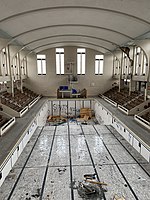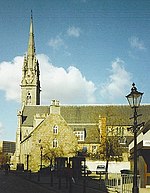Crabstane of Aberdeen
Buildings and structures in AberdeenHistory of AberdeenMonuments and memorials in AberdeenUse British English from January 2018

The Crabstane (alt. Crabs Stone, Craibstone, Craib Stone, Craibstane or Crabe Stone) is a boundary stone that used to mark out part of Craibstone Croft which was located near Hardgate, Aberdeen.The stone has a plaque above it with the inscription as follows: The Crabstane. Boundary stone on lands belonging to John Crab, Baillie of the Burgh in 1314. The stone also marks the site of the skirmish in 1571 between the rival families of Gordon and Forbes and of an engagement in 1644 between the citizens of Aberdeen and the Royalist forces of the Marquis of Montrose. The skirmish refers to the Battle of Craibstone on 20 November 1571.
Excerpt from the Wikipedia article Crabstane of Aberdeen (License: CC BY-SA 3.0, Authors, Images).Crabstane of Aberdeen
Langstane Place, Aberdeen City City Centre
Geographical coordinates (GPS) Address Website Nearby Places Show on map
Geographical coordinates (GPS)
| Latitude | Longitude |
|---|---|
| N 57.142919 ° | E -2.108102 ° |
Address
Spiritualist
Langstane Place 67
AB11 6EN Aberdeen City, City Centre
Scotland, United Kingdom
Open on Google Maps








